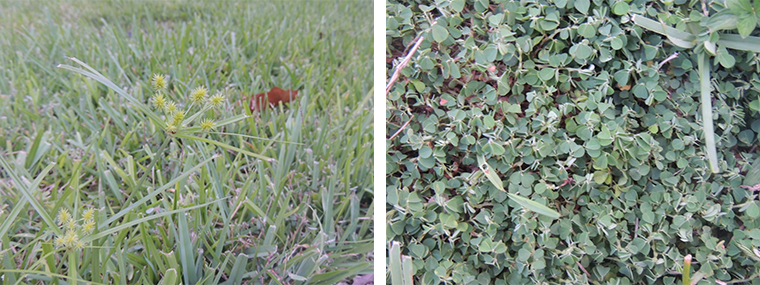
Managing Weeds in Florida Lawns
By Lynn Barber / Published December 2015

A weed is a plant in the wrong place or one that you do not want in your turfgrass. The first step in considering any type of weed control is to appropriately identify the weed. Control without weed identification may well create more issues, including turfgrass damage or death.
There are several types of turfgrass weeds based on growth habit and life cycle. Growth habit weeds include the following:
- Broadleaves—Two seed leaves at germination, true leaves with net-like veins, and generally showy flowers; clover, beggarweed, matchweed, etc.
- Grasses—One seed leaf, hollow rounded stems with joints and parallel veins in their true leaves; crabgrass, annual bluegrass, torpedograss, etc.
- Sedges/Rushes—Sedges have triangular-shaped solid stems. Rush stems are round and solid. Both prefer moist habitats; yellow and purple nutsedge, etc.
Life cycle weeds include the following:
- Annuals—life cycle is completed in one growing season.
- Biennials—life cycle is completed in two growing seasons; vegetative growth in the first growing season and flowering in the second.
- Perennials—life cycle is completed in three or more years.
The most successful weed control is based on proper turfgrass management practices that are used to create a dense and healthy yard. Consider the first of nine Florida-Friendly LandscapingTM principles: right plant, right place. Match the turfgrass variety with the site conditions of sun and shade. All turfgrasses, even those that are shade tolerant, require a minimum of five to six hours of sun each day. Bermudagrass and bahiagrass do not thrive in any shade conditions, which makes them more susceptible to weeds.
Proper cultural practices are required for dense turf to be capable of preventing weed infestations. Cultural practices include fertilization, watering, mowing, and pest control. Over and underperforming any of these practices increase the likelihood of weed invasion.
Both foot and vehicle traffic can damage turfgrass, which, again, is an invitation for weeds. Soil compaction and excessive water saturation should be corrected. Pests that disrupt/create holes in the soil surface, such as mole crickets and armadillos, create open areas, which encourage weed populations.
Lynn Barber, Agent
University of Florida/IFAS Extension, Hillsborough County
Lynn Barber, Agent, University of Florida/IFAS Extension, Hillsborough County, is responsible for educating residents on the nine principles of the Florida Friendly LandscapingTM program. These principles include right plant right place, water efficiently, fertilize appropriately, mulch, attract wildlife, manage yard pests responsibly, recycle, reduce stormwater runoff, and protect the waterfront. Barber is past president of the Florida Association of Natural Resource Extension Professionals and has received numerous awards for programming, publications, and television and radio segments. As a Master Gardener, she has given back thousands of hours in environmental horticulture education to the community.
Prevention is easier than control. Consider a groundcover instead of turfgrass in heavily-shaded areas. Scout your turfgrass regularly to identify potential weed and pest issues. Avoid parking, driving, and excessive walking on your yard. Water appropriately, ½–¾ inch per event, which includes rainfall. Fertilize appropriately, two to three times per year, and if you leave your grass clippings on your turfgrass, you can decrease fertilizations to one to two times per year.
Weeds can be controlled using the following methods:
- Mowing—at the proper height and frequency for your turfgrass variety, remove no more than 1/3 of the leaf blade and mow when turfgrass is dry.
- Hand pulling—if few weeds are present, this can be less time-consuming and easier than some options; remove roots, may need a trowel or shovel.
- Herbicides—any chemical that damages or kills a plant, must follow the label instructions, the label is the law. Herbicides can be selective (control specific weeds without damaging other plants), nonselective (control/kill all plants), contact (affect only the portion of the plant tissue contacted by the herbicide), and systemic (kill plant over several days). Herbicides can be pre-emergence or postemergence. Pre-emergence are mainly used to control annual grasses (crabgrass, annual bluegrass) and some annual broadleaf weeds. This product is used before weed seed germination. Post-emergence herbicides are used on weeds that have emerged. It is easier to control younger versus older weeds.
For additional information on controlling weeds in your lawn, weed control prior to turf establishment and in established turfgrass areas, application procedures and general pesticide information, please see the University of Florida publication, Weed Management Guide for Florida Lawns, by J. Bryan Unruh, Ramon G. Leon, Barry J. Brecke, and Laurie E. Trenholm at: edis.ifas.ufl.edu/ep141, from which this article was adapted.
As always, follow the landscape or architectural control procedures in your deed restrictions before making changes. For more information about the nine principles of the Florida-Friendly Landscaping™ Program, or for assistance with gardening-related questions, contact your local Extension office and/or visit the University of Florida website: solutionsforyourlife.com or edis.ifas.ufl.edu.


